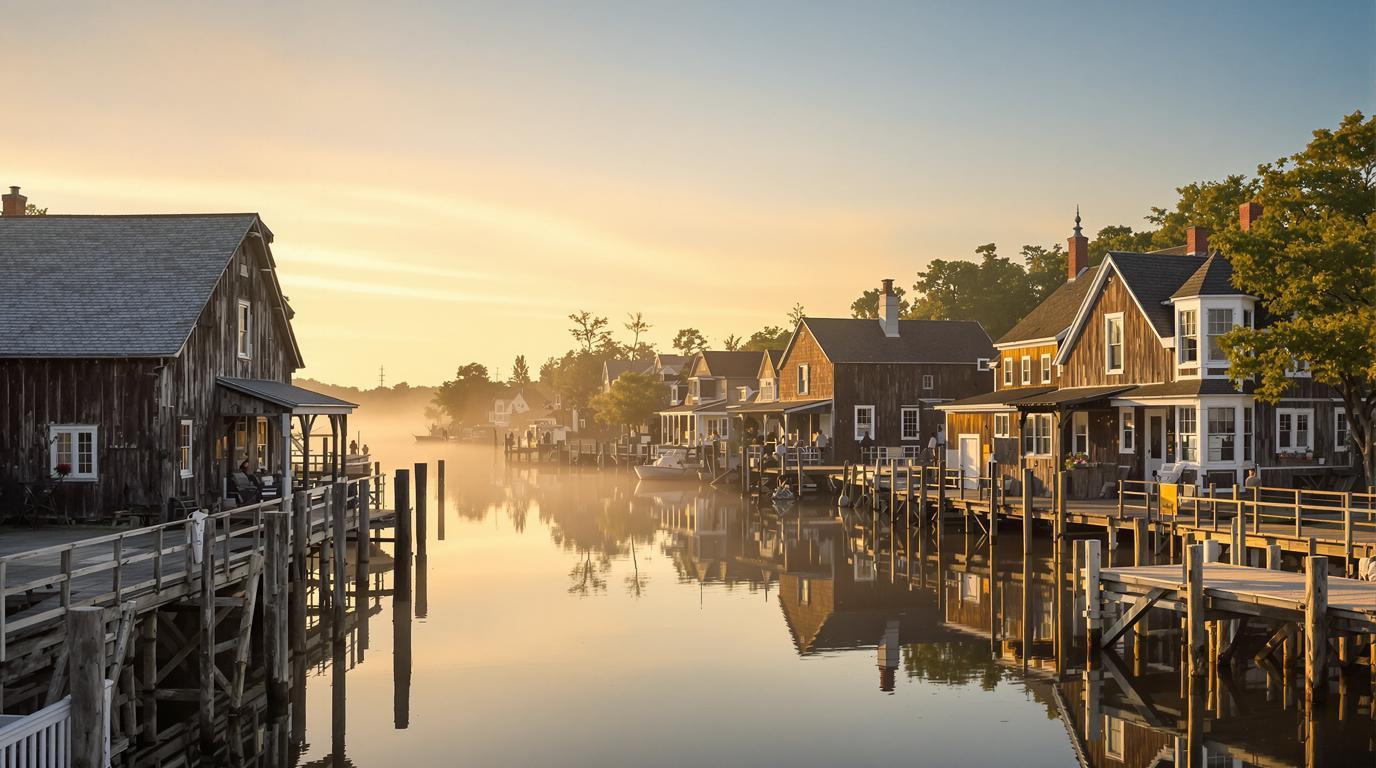The fog lifted off the Miles River at dawn, revealing what locals quietly call “the town that fooled the British.” While weekend warriors flood Annapolis marinas just 45 minutes away, I discovered this 1,059-resident sanctuary where 250-year-old maritime secrets still echo through narrow streets lined with shipbuilders’ cottages.
St. Michaels, Maryland, isn’t just another Chesapeake Bay postcard destination. This 1.25-square-mile waterfront community has perfected the art of hiding in plain sight, preserving authentic Eastern Shore culture while tourist buses bypass its quiet charm for flashier destinations.
What drew me here wasn’t the polished maritime museum that everyone photographs. It was the whispered stories of how this humble fishing village outsmarted the British Navy in 1813, earning its legendary nickname through pure Chesapeake ingenuity.
The maritime deception that saved a town
When lanterns became weapons of war
The Battle of St. Michaels reveals why locals guard their town’s authentic character so fiercely. During the War of 1812, British warships approached under cover of darkness, ready to bombard this shipbuilding stronghold that had been crafting those lightning-fast schooners plaguing Royal Navy vessels. But townspeople devised a brilliant deception: they hung lanterns high in treetops beyond the town limits, causing British cannons to overshoot their targets. Only one building suffered damage—the Cannonball House, which still bears scars from that fateful night.
The shipbuilding legacy tourists overlook
While visitors flock to the obvious maritime attractions, they miss the real story written in the town’s 18th-century architecture. Six active shipyards once operated here, their skilled craftsmen launching vessels that would challenge British naval supremacy. Walking past the Victorian Corn Cribs and St. Michaels Mill—both listed on the National Register of Historic Places—reveals how this community evolved from strategic shipbuilding center to the serene sanctuary it remains today.
Hidden authenticity beyond the tourist trail
The Episcopal parish that started it all
Founded around an Episcopal parish established in 1677, St. Michaels predates most Eastern Shore settlements by decades. Unlike Oxford’s 663 residents or Easton’s comparable size, this community maintained its maritime identity through centuries of change. The historic district showcases original shipbuilders’ homes, their weathered cedar shingles and brick chimneys telling stories of families who lived and breathed Chesapeake Bay traditions.
Local gathering spots where authenticity thrives
The Old Inn, another National Register property, serves as an unofficial community center where watermen still discuss crab harvests and sailing conditions. Here, conversations flow in the distinctive Eastern Shore cadence that’s disappearing from more developed coastal towns. Unlike Virginia’s colonial showplaces, St. Michaels remains a living community where maritime traditions continue naturally.
The exclusive experience locals reluctantly share
Summer’s secret rhythms
July brings warm humid subtropical weather perfect for exploring on foot, but locals know the real magic happens at dawn when mist rises from the Miles River. Early morning walks reveal working boatyards where traditional techniques still shape modern vessels, and the town’s compact 1.15 square miles of land can be thoroughly explored before crowds arrive.
Maritime culture beyond the museum walls
While the Chesapeake Bay Maritime Museum draws most visitors, authentic experiences await in unexpected places. Similar to Vermont’s hidden waterfront gems, St. Michaels rewards those who venture beyond obvious attractions to discover working watermen’s docks and traditional crab houses where locals still gather.
Travel Note: The best time to experience authentic St. Michaels is weekday mornings when working boats head out and the town belongs to its residents. Avoid summer weekends when day-trippers can overwhelm the narrow streets.
Insider access to Chesapeake authenticity
The seasonal advantage visitors miss
Summer 2025 offers perfect timing for experiencing St. Michaels as locals do. Like Pennsylvania’s hidden artisan communities, this town reveals its deepest secrets to visitors who respect its rhythms and approach with genuine curiosity rather than camera-first tourism.
Why locals hope you’ll choose elsewhere
With only 1,059 full-time residents, St. Michaels feels the impact of every visitor. Yet those who arrive quietly, explore respectfully, and engage authentically often discover that this “town that fooled the British” continues its tradition of rewarding cleverness over force, subtlety over showmanship.
In an age of manufactured experiences, St. Michaels offers something increasingly rare: authentic maritime culture that has survived by staying true to itself. The question isn’t whether this Eastern Shore sanctuary will charm you—it’s whether you’ll recognize its quiet magic before others discover what locals have protected for 250 years.
Essential questions about St. Michaels
What makes St. Michaels different from other Chesapeake Bay towns?
St. Michaels maintains active maritime traditions within a historically preserved setting, unlike more commercialized destinations. Its 1,059 residents keep authentic Eastern Shore culture alive while carefully managing tourism impact on their small 1.25-square-mile community.
When is the best time to visit for authentic experiences?
Early morning weekdays during summer months offer the most authentic experience, when working boats are active and locals go about their daily routines. Avoid summer weekends when day-trip crowds can overwhelm the town’s intimate character.
How does St. Michaels compare to Annapolis for maritime culture?
While Annapolis focuses on sailing and naval history, St. Michaels preserves working watermen traditions and shipbuilding heritage. Its smaller scale allows for more personal interactions and authentic cultural experiences away from large tourist crowds.
What historical sites do most tourists miss?
The Cannonball House, Victorian Corn Cribs, St. Michaels Mill, and Old Inn offer rich historical context beyond the maritime museum. These National Register properties tell the complete story of how this community evolved from strategic shipbuilding center to preserved sanctuary.
Is St. Michaels worth visiting if I’m not interested in boating?
Absolutely. The town’s architectural heritage, War of 1812 history, and authentic Eastern Shore culture provide compelling experiences for history enthusiasts, architecture lovers, and anyone seeking genuine small-town American character preserved in its original maritime setting.
